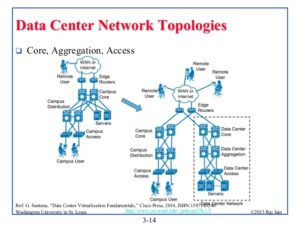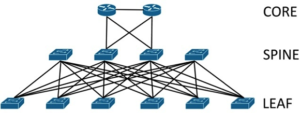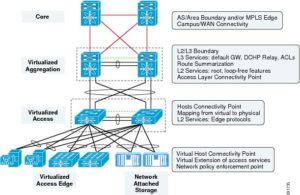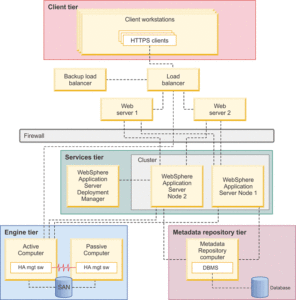Data Center topologies

Welcome again to a new post from the Net Company. In this entrance we will propose different data centers (DC) topologies and which one would we choose from the point of view of a rising institution.
First of all, we need to know that the topology that we will choose it’s divided on several layers, that’s because every existing topology is based on layers; this layers use to be access, aggregation and core; the first one is used to let you connect your devices to access the network, the second one will ensure that your communication with core it’s fluent, and the third one use to storage your application or service.
We will assume that because you are building your network you still do not have many devices to plug, that’s why we will work with a topology where the aggregation layer and core layer are merged, this is the so called merged-core, and this topology will provide you scalability, flexibility, resiliency and ease of management. But this is only the easy part, we still have to decide how to orientate our DC architecture, and the answer will be, that depends on what you need.
There is a lot of possibilities, like this:
But we are going to recommend you what we thing is better for you .The first option we are going to introduce you to it’s the multi-tier architecture for DC, oriented to sustain HTTP-based applications. This architecture uses software that runs multiple processes on the same machine, as the need of computing grows more machines can be incorporated to the topology and the processes on every machine can communicate with other processes on other machines using network connections. This model provides security and resiliency, but it’s not very scalable, as the bandwidth it’s swiftly consumed, so we do not recommend this one except for temporal deployments or economic reasons.
Then, another option for the architecture of our DC is the Server Cluster. This architecture it’s focused to environments that need a high processing power. The applications that work with real-time analysis and high rendering shall be based on this architecture.
HPC clusters is an architecture oriented to applications which need a high performance capability, the need which may bring you here it’s the same than before, but with one more thing, the high computational cost of getting you service ready, there are various types:
- Type 1: various parallel nodes compute results for multiple applications, a master node manage the queue of requests.
- Type 2: is the fastest architecture. A request is balanced across master nodes and sent to a cluster for parallel processing.
- Type 3: The data is divided at the arrival of the data center and sent to parallel computing to various clusters.
Type e and 3 are orientated to entertainment and financial applications; the first one was the original architecture, base of the types 2 and 3.
Even though there is a plenitude of architectures more, we are only exposing one more. The fat tree topology, this topology was created to solve some problems left by the multi-tier architecture, which under a lot of traffic used to spend too much CPU and bandwidth to communicate with among clusters, adding links was not scalable anymore. A topology fat tree is characterized because the number of links which interconnect nodes increase by a mathematic expression as the data goes deeper into the network of the cluster, this provides the capability of higher redundancy, bandwidth and velocity, as a plus it turned to be very economic so it’s a common answer for most data center scenarios. If you were interested in the first option of multi-layer, this one may accommodate more to your needs.
About the links used on the network, the trends indicate that nowadays your topology should be built with 10GB Ethernet or more, but not below, this is because probably much of the features that you need for your network can be virtualized, and also the networks which can’t be virtualized may see their scalability very diminished in the near future.
Also it’s a good idea to think on how you want to build up your racks, the best options for data-center architecture is the: End-of-Row architecture and Top-of-rack architecture.
End-of-Row this one is better when the resources of the DC are centralized
Top-of-Rack with that one we will optimize the resources on a modular development of our DC
Those were our councils for today folks! We hope that they help you.




